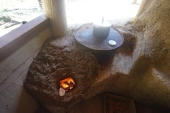When I got my first RMH assembled enough to do a test fire I immediately encountered the reality of operating a low temp exhaust system in a marginal climate. If your exhaust temps are around 150 F then your draft is not that strong. If you live in a climate like mine, where winter temps can swing from the 20's to the 50's and include rain and wind, then a RMH can be pretty finicky and hard to start on mornings when temps are warmer and/ or the wind is blowing. You can deal with this by priming the flu, but a bypass seems to be a more sure bet. I realized this a bit late into the game, and after considering various options decided to try making my exhaust flu adjustable where it exits the split barrel bench bell. Lift the pipe to the highest position as a bypass, so the hot gasses bypass the bench entirely, and then lower it once draft is primed. I was wary of the idea of trying to slide a pipe up and down through cob - I suspect it would be challenging to maintain a good seal over time, and the pipe is going to expand and contract at a different rate than the cob. So I used a telescoping stove pipe.
I cut the outer sleeve as shown below and bolted it to the barrel, the inner sleeve slides up and down through it. It's functional, but still needs some tinkering to make it easier to use. I'm able to raise the flu for starting, and then lower it once the RMH is drafting well. (I only need the bypass when the RMH is cold or when weather is windy and/or warmish). One challenge I have is that the exhaust stove pipe is not straight, it jogs a bit through two 45 degree elbows between the bench and the ceiling, so it's hard to keep the upper part of the stove pipe stationary while I slide the adjustable sleeve up and down. I fabricated some brackets to try to hold the pipe firm, but there are several angles and they did not come out quite right, I need to fabricate something adjustable so that I can dial in just the right amount of support and tension on the flu, not too much, not too little. I'll be fiddling with this some more in the weeks to come, for now it works fine.
Not all telescoping stove pipe is created equal. Duravent makes 2 models of telescoping stove pipe under the brand Durablack. I found the one offered by Northern Tool & Equipment to be the best:
https://www.northerntool.com/shop/tools/product_200447737_200447737?cm_mmc=Google-pla&utm_source=Google_PLA&utm_medium=Heaters%20%26%20Stoves%20%2B%20Fireplaces%20%3E%20Heater%20%26%20Stove%20%2B%20Fireplace%20Accessories&utm_campaign=DuraVent&utm_content=710700&gclid=Cj0KCQjw28T8BRDbARIsAEOMBcz_hwIUmxLmf_e99w6rTFc_scGV44nvhjH2TrkfBjA7v_X31yMRbPIaAuI7EALw_wcB&gclsrc=aw.ds
There is another made by Duravent under the Durablack label that is much lower quality, the sleeve does not fit as tightly and I would bet it's subject to leaking. I'm including labels of the two in the photo below.
Would love to hear more about what other folks are doing for a bypass. I'm surprised I don't see more posts and discussion on bypass ideas and designs on this forum, is this because most RMH users are in cold climates that don't require them? I'm considering another post on RMHs in marginal climates...




 2
2













 1
1










